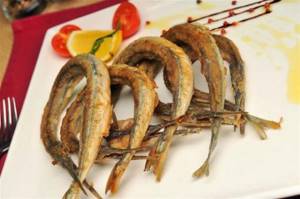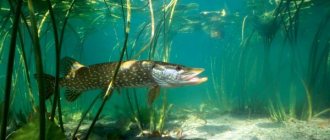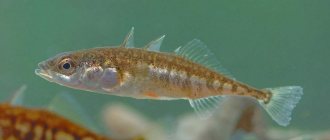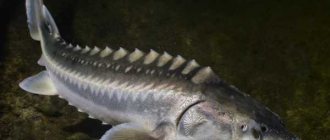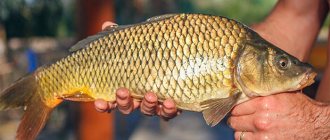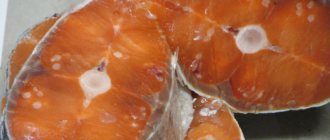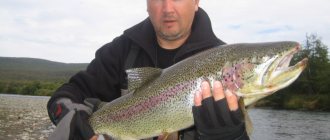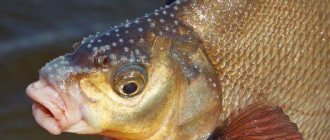Garfish otherwise called arrow fish. The popular name emphasizes the thinness and elongation of the animal. His body resembles a ribbon, and his long nose resembles a needle. The jaws open like a beak. Inside it is strewn with sharp and thin teeth.
The appearance is exotic and the taste is excellent. Garfish has fatty, white and soft meat. There are minimal bones in it. Therefore, fishermen are not embarrassed by the small “exhaust” of meat. If you are cutting an arrow fish for the first time, it is interesting to look not only at its appearance. The water dweller has green bones.
Origin of the species and description
Photo: Sargan
Any of the subspecies of garfish belongs to the garfish family. By the way, the most interesting is the variety of fish that also belong to this species. This includes both the quite typical saury and exotic tropical flying fish.
Belonging to the garfish is based primarily on the special arrangement of the head bones. First of all, the garfish is distinguished by the ossification of some cartilages, which explains, in particular, the immobility of the upper jaw. The digestive tract is not connected to the air bladder - this is another important species feature of garfish.
Video: Sargan
It should be taken into account that garfish are among the oldest subtypes of fish that have inhabited the waters of the World Ocean for many millennia. It is from them that many other species of garfish originate.
Although garfish belong to predatory fish, they cannot be classified as particularly dangerous or aggressive. It also cannot be said that garfish cause too much harm to other fish. More questions arise about the distribution of the species in the basin of the Black and Azov Seas, because in many ways these fish prefer large expanses of the ocean due to their overly active lifestyle. This may be due to the fact that the Black Sea garfish is smaller in size and does not exceed 60 cm in length, while other varieties can reach 1.5-2 m.
Interesting fact: The largest representative of the garfish, the crocodile, is dangerous to humans. It lives near coral reefs and can reach 2 m in length. At night, the garfish rushes towards the light of lanterns, developing such a speed that it can easily injure fishermen and even some boats. The name of the subspecies is due to the fact that the jaws of the crocodile garfish are very similar to the teeth of the crocodile itself.
How, where, when and what to fish for garfish
Usually the garfish is located far from the shore. Approaches to capture prey or spawn. The insatiable garfish will always be nearby near a school of small fish that gathers along rocky shores, bays and reefs.
5.1 Biting calendar – what time of year and day does the garfish bite best?
As the temperature of the water increases, garfish go to the sea, where they can be hunted from sea transport.
In cold weather the fish bite throughout the day. Favorable times for fishing in shallow coastal areas are dark and early morning.
5.2 What weather is the best time to bite?
It bites well in the autumn and until mid-spring, especially with wind, waves of 1 m and turbidity of the water. The water temperature should be less than 10 degrees. Under such conditions, the garfish approaches the shore for food, near which small fish swim.
5.3 What are the best places to catch garfish?
The best fishing distance is considered to be from 40 to 100 m. Coastline, bays, coral reefs and bays. During the low tide period, the garfish hides in drained places, burrowing into the mud up to a meter deep. Fishing on sea spits will allow you to move away from the shore.
A promising location will also be the surf zone, which extends many meters into the sea. Fishing from the rocks can allow you to successfully catch garfish, as they are fearless in such places.
For a fisherman, ports will seem like an interesting place to fish. Here there are various structures separating shallow and deep places, and the bottoms of the boats are covered with algal vegetation and attract small fish, which are hunted by garfish.
Good places can be those with a quiet current. Also, attention should be paid to areas where the slow current borders on the fast one; here the water is enriched with oxygen and attracts small fish, which are food for most predators, including garfish.
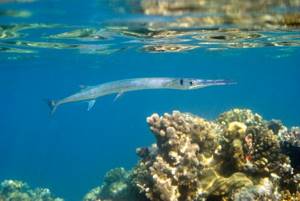
5.4 What gear to use for catching garfish
When fishing for garfish, preference is almost always given to gear for long casting.
Option 1 “For spinners” Spinning rod with a length of at least 3 m:
- high-speed inertia-free reel (with a gear ratio of more than five to one);
- oscillating, narrow, heavy lures of bright color - size from 7 to 9 cm and weighing from 16 to 26 g (for example, Kingtrout, Filur, Trumf);
- tie the spoon through a carabiner with a rotating swivel (without jamming), to avoid twisting of the fishing line;
- monofilament fishing line – 0.2 mm (promotes long flight of the spinner) or braided cord;
- The tee on the spoon is attached using 3 - 5 rings or put a metal chain up to 5 cm in length. Lengthening and making the tee freely rotating in order to wrap around the “beak” of the fish and hook onto the hook.
Don’t know anything about the numbering of fishing swivels and carabiners? Then read this article - here
Here you can find the most inexpensive but reliable swivels and carabiners from Aliexpress at the most tempting price! - Here
Who doesn't know yet? You can return up to 15% of the price of your purchase on aliexpress. In addition to Aliexpress, the possibility of cashback (returning part of the money) also works for many other online stores. Here is a detailed description of this service and everything about how to work with it. It really works and helps you save a lot of money. The cashbacker website often runs promotions that allow you to buy goods at a discount of up to 90%.
Option 2 “Float” Spinning up to 4 m:
- spinning reel;
- sliding float (20 – 40 cm) with a bright top with a load of up to 5 g;
- colorless (transparent) thin fishing line with a diameter of up to 0.25 mm;
- leash (0.12 – 015 mm) and 0.5 m long
- red fishing hook (No. 2.5 – 5);
How to choose a fishing hook - practical recommendations here
Option 3 “Fly fishing without using a hook”
- a small cork ball (about the size of a pea) is attached to the tip of the fishing line;
- A tassel is made, and knots of colored silk threads up to 15 cm long are knitted at the end.
The pieces are folded in half, loops are made and placed on a fishing line over the cork, everything is straightened out and secured with thread. When the garfish grabs the bait, such knots will get caught in its teeth, and it will not be able to untangle itself.
For fly fishing enthusiasts and fans of ultralight gear, we present an article about a very useful piece of equipment - a fly fishing fastener. Here you will find its description, purpose and conditions of use, get acquainted with the shapes of the fastener and explore options for making it at home, and photos and videos will help you with this - read here
Advice:
- fishing time - early morning;
- long cast;
- drive quickly through the water;
- bringing it to the shore, sharply pull it out of the water with a fishing rod;
Option 4 “Fishing with a petal and a hook” Two-handed spinning rod:
- spinning reel;
- fishing line 0.25 mm thick;
- a sinker weighing 10–15 g is attached to one end, and a factory ring with a carbine and swivel is attached to the other;
- at a distance of 10 - 15 cm from the ring, a leash 3 - 4 cm long with a diameter of 0.2 mm with a small tee is attached;
- after 10 cm, a leash with a white spoon petal is attached;
- then the leash and tee are knitted again.
Read all about how to correctly and securely tie a fishing swivel to various types of fishing lines, elastic bands and other fishing accessories - here
Advice:
- wiring is done on the surface of the water;
- You can also use yellow petals.
Option 5 “Christmas tree fishing”
- on leashes - 4 or 5 cm, attach 2 - 3 oscillating spoons or jigs with 2 hooks;
- silver tee.
Advice:
- bait no more than 3 cm;
- leashes at a distance of 20 – 25 cm
- trailing narrow spoon – 100 – 110 cm
- use silver metallic spinners
Option 6 “Fishing with long casting” Carbon fiber tackle up to 8 m long:
- inertia-free or multiplier reel;
- fishing line with a diameter of 0.18 mm;
- a large elongated float with a long antenna;
- a sinker (olive) with built-in foam is attached to the float itself;
- weight - a pellet is attached at the end of the fishing line, to which a leash (0.15 mm in diameter), 25 - 30 cm long, is tied (loop to loop);
- hook No. 4 – 6 (long shank).
Read about how to choose the right baitcasting reel for spinning fishing - here
Advice:
- the float is released to a depth of 1 - 1.5 m;
- you can use a float with a mounted sinker;
- It is possible to tie a float to the end of the fishing line and a leash at a distance of 1 m from it.
Option 8 “Fishing with a bombard” Spinning up to 4 m and 10 – 40 g dough:
- spinning reel;
- monofilament line (0.32 - 0.35 mm) or braided cord 0.15 - 0.20 mm;
- hooks No. 6,7 (flattened to the sides and with a long shank);
- tie a shock leader to the fishing line, onto which attach a 10 - 40 g bombard;
- after the bombard, place a bead and tie a swivel;
- Attach a 2 m leash to the fishing line through a swivel.
Advice:
- have bombards of different weights, depending on the weather and conditions;
- use a thin cord with a diameter of 0.1 mm;
- first you need to assemble the tackle without a leash, only with a bombard;
- you need to wet the line, for this you cast without bait;
- when using a fishing line, do the hooking slowly with a large amplitude;
- When using a cord, hooking is done only with the hand.
Read the section about existing fishing techniques: types, features, videos and execution schemes - here
Famous video about how to catch garfish - part 1
Part 2
5.5 Baits for catching garfish
At the moment there is no information about bait for garfish. I would be grateful for any information on this issue.
5.6 What baits and baits do garfish bite on?
Animal nozzles
- worm (dung worm, dendrobena, earthworm);
- estuary worm (Nereis);
- shrimp meat;
- crab meat;
- pieces of fish;
- chicken breast pieces;
- fresh frozen salmon meat;
- pieces of garfish.
How to properly and securely attach a worm to a hook - read here
Plant attachments
- dough (eg pilota)
Artificial baits Spinner baits:
- fluctuating (size 2, 3, weight 10 - 20 g, color on a sunny day - silver, on a cloudy day - dark lead;
- with a holographic pattern (long and weighing up to 25 g);
- oscillating re-equipped (with 2 large and connecting rings);
- with a silk brush.
Wobblers:
- superficial (heavy);
- bladeless (for long casts and fishing at depth).
Other:
- silicone worms.
Everything you didn’t know about silicone baits: their types, features and secrets - here
Advice:
- Cut chicken meat with film into strips (4 cm), the film will betray its strength when thrown;
- Also cut pieces of fish (sardines) with skin;
- shrimp meat is less durable;
- To preserve Nereis, pour vodka into a jar of worms, close the lid and place in the refrigerator. Store for unlimited time.
5.7 How a garfish bites
Strong fish, loves to fight. The bite is confident: it sinks the float, swallows the bait and abruptly drags it into the water. Do not rush to hook so that the hook does not slip off. However, with active fishing, you need to hook quickly. Once hooked, it begins to pull. When fishing, there is a struggle on the surface of the water. Once ashore, it aggressively resists.
5.8 How to catch garfish correctly? – Basic techniques
- when the bite is sluggish, the hook is made with a pause of a few seconds, preventing the spoon from sinking to the bottom.
- in shallow water, long-distance casting and wading are used (fishing by entering the water);
- Fishing on a rocky area is dangerous, as the stones have a slippery surface. To do this, it is better to fish from the water. The fish tank is attached to the belt;
- To ensure that the landing net does not interfere during the process, you should hold it behind your back.
- When fishing along a sandy bottom, a fish tank is not needed. Such a bank allows you to calmly grab the fish with your hand and remove it from the hook;
- make fan casts, starting along the coastline, then a semicircle in places where fish accumulate;
- the retrieve speed is fast, allowing the spoon to jump out of the water;
- if a predator breaks, do not stop wiring, as garfish may follow it;
- If there is no bite, change the spinner to a different color.
5.9 The most important points when fishing for garfish
- choose equipment depending on weather conditions, behavior of water and wind;
- observe safety precautions while fishing;
- have equipment, clothing and polarized glasses appropriate for the weather and fishing location.
Appearance and features
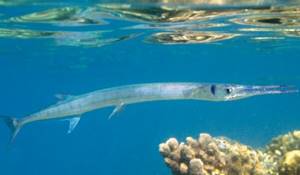
Photo: What a garfish looks like
The garfish has a remarkable original appearance, thanks to which it never goes unnoticed. At the same time, disputes often arise about its species, since the garfish can easily be confused with an eel. Most often, garfish are compared to needle fish.
All these comparisons are due to his distinctive appearance. The gar has a long, elongated body, slightly flattened at the sides. The jaws are also elongated and resemble large tweezers with sharp, well-developed teeth. If you look at the garfish from the front, you will notice that the jaws are strongly narrowed in front. This makes the garfish similar to sailfish and even to ancient lizards - pterodactyls. Although garfish cannot possibly be their descendants, a similar version is voiced in almost all sources. Often set with small, sharp teeth make this resemblance even more pronounced.
The pectoral and dorsal fins are located at the back of the body. Because of this, the flexibility of the garfish increases significantly. A lateral line stretches from the pectoral fin to the tail, which in representatives of this species is significantly shifted downward. The caudal fin is forked and small in size. The scales of the garfish are small and have a distinct silvery tint. In total, the body of the garfish has 3 different shades: the top of the back is dark with a greenish tint, the sides are gray-white, but the belly has a very light shade with silver.
The head of the fish at the base is very massive and wide, gradually narrowing towards the end of the jaws. Against this background, the garfish received a second unofficial name: arrow fish. The garfish's eyes are large and well-pigmented, which allows it to navigate perfectly even in low light.
Interesting fact: Garfish bones have a green tint. Because of this, in some countries they refuse to eat fish at all. In fact, it is completely safe, and this shade is simply associated with the presence of biliverdin in the body (a greenish pigment found in bile).
Distinctive features
The average size of a garfish can be up to 80 centimeters. Despite the narrow, elongated mouth, it holds prey very tenaciously with sharp jaws. Belongs to the subclass “ray-finned” and the superorder “true teleosts”.
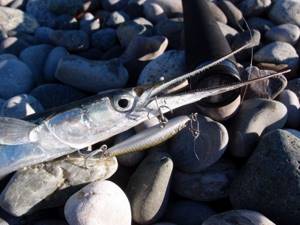
According to the photo and description of the gar fish, it is characterized by the following features:
- Thin, medium-sized scales with smooth edges
- There are no spiny rays on the fins
- Has a gray-bluish color
- The dorsal and anal fins are identical in shape, close to the tail
- Bones are green due to a special pigment called biliverdin.
Although biliverdin appears unpleasant in the photo of garfish, it is absolutely safe. Pigment is formed as a result of the breakdown of blood cells in the brain. The bony part is never eaten, so there is no need to worry.

Where does the garfish live?
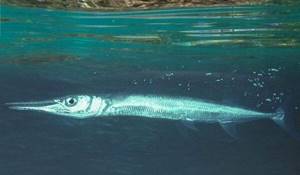
Photo: Gar fish
In total, there are about 25 subspecies of garfish. Depending on which one is being considered, the habitat will also differ.
It is customary to generalize all fish into genera and divide them into 5 different ones:
- European. The most common species, which is not located in one place - it is characterized by constant seasonal migration. In summer it comes to the North Sea to replenish lost food. With the arrival of autumn, the fish move to the region of North Africa, where it is warmer;
- Black Sea. Despite the name, it is found, in addition to the Black Sea, also in the Sea of Azov;
- ribbon-shaped. It prefers exceptionally warm water, so it lives only near islands. Sea estuaries and estuaries are also among its favorite habitats. It is impossible to single out any clear area - banded saran is found in different areas of the World Ocean;
- Far Eastern. Most of the time it lives off the coast of China. In summer, it often approaches the Russian Far East;
- black-tailed (black). Found near South Asia, it tries to come as close to the shore as possible.
By the way, garfish cannot be completely classified as marine fish. There are also species that prefer fresh water from rivers. These are most often found in the rivers of India and South America, preferring a tropical climate. Based on this, we can draw conclusions: the garfish does not have any clearly defined habitat boundaries.
Fish can be found almost everywhere, its species will just be different. Sargan prefers to be closer to the surface of the water or in its thickness, but avoids too great depths or shallows.
Now you know where the gar fish is found. Let's see what she eats.
Population and species status
The European garfish is quite widespread in the Atlantic, as well as the Black, Mediterranean and other seas, but it is difficult to calculate the size of its population, like other schooling fish. However, the existence of thousands of schools of these fish indicates that they are not in danger of extinction. Currently, the common garfish has been assigned the status of "Species of Least Concern". Svetovidov's garfish, apparently, is also quite prosperous, although its range is not so extensive.
Sargan is an amazing fish, distinguished both by its appearance, which makes it look like a relict extinct lizard, and by the peculiarities of its physiology, in particular, by the unusual green tint of its bones. The shade of the skeleton of these fish may seem strange and even scary. But garfish are tasty and healthy, and therefore you should not, out of prejudice, refuse the opportunity to try a delicacy made from the meat of arrow fish.
Tags: European garfish, arrow fish, fish, garfish, Svetovidov's garfish
What does a garfish eat?
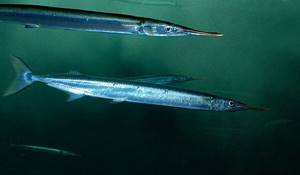
Photo: Black Sea garfish
Invertebrates, mollusk larvae and even small fish are the main food for garfish. Schools of garfish begin to pursue young mullet and other potential prey all together.
But garfish are not always lucky enough to encounter such food on their way. That’s why small fish are a kind of delicacy for them that they don’t come across very often. The rest of the time, garfish have to be content with various kinds of crustaceans. They can also pick up large insects on the surface of the water. Garfish also move in search of food for various small sea inhabitants.
Their route can be divided into 2 large types:
- from the water depths to the surface of the water. The arrow fish makes this journey every day;
- from the coastal zone to the open sea - seasonal migration of schools of fish.
The gar can move very quickly, making wave-like movements with its elongated body. Also, if necessary, a garfish can easily jump out of its water to overtake its prey. By the way, in extreme situations, a garfish can even jump over obstacles. Unlike many other fish, garfish do not consume plant foods. Even in conditions of food shortage, he will not eat algae.
Interesting fact: The garfish moves simply by making wave-like movements with its body. This allows the fish not only to move at very high speeds, but also to jump out of the water. In some cases, garfish can reach speeds of up to 60 km/h in water.
Garfish diet
It feeds mainly on smaller fish, as well as invertebrates, including mollusk larvae.
Schools of garfish are chased by schools of other fish, such as sprat or European anchovy. They can prey on small sardines or mackerel, as well as crustaceans such as amphipods. On the surface of the sea, arrow fish pick up large flying insects that have fallen into the water, although they are not the basis of the diet of garfish.
Arrowfish are not too picky about food, which is the main reason for the well-being of this genus for a couple of hundred million years.
In search of food, garfish, following migrating schools of small fish, make daily migrations from deeper layers of water to the surface of the sea and seasonal migrations from the shores to the open sea and back.
Return to content
Features of character and lifestyle
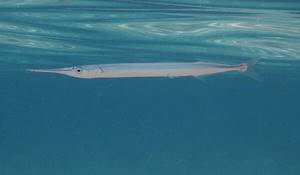
Photo: Common garfish
Sargan is a predatory fish. The bulk of his habits and habits are associated with hunting. The garfish is not too picky in terms of prey, so it prefers to attack quickly and aggressively. Smaller species try to flock together to make it easier to attack prey and protect themselves from opponents.
But large individuals are more cunning: they hunt only themselves, preferring not to attack sharply, but to wait quietly for the prey in ambush. It perceives any other garfish in this territory solely as rivals and can engage in battle with them. Sometimes these clashes can even end with the stronger garfish eating the enemy.
Sometimes you can find garfish even in private collections. But you need to be prepared for the fact that garfish are very difficult to keep at home. This is a very capricious fish in terms of conditions, requiring highly qualified aquarists. Although in this case garfish do not grow large, they require a lot of living space, since the fish is accustomed to an active lifestyle.
In captivity, sometimes they can even eat their neighbors in the aquarium in order to increase their living space. Bloodworms, tadpoles and other live food are what you will need to feed the garfish. It is also important to control the temperature (up to 28 degrees) and acidity of the aquatic environment. You should also be extremely careful: the fish can jump out of the aquarium, injuring the owner. She can also harm herself by simply breaking her jaw.
By the way, the danger to the garfish’s jaws remains in the natural environment: the fish can often break them during the process of catching food, battles and other moments. Although the jaws are powerful, they are very thin, and therefore are the most vulnerable point of this fish. The life cycle is directly related to water temperature: garfish intuitively tend to those areas where it is warmer.
Interesting fact: Some types of garfish, in order to wait out the drought, burrow deep into the ground during low tides and wait for the water to return. This is typical for those garfish that prefer to come very close to the shore.
Lifestyle and habitat
The garfish is an indiscriminate predator. A high-speed attack is the main type of attack of this fish. Large species prefer solitude. Victims are waiting in ambush. Neighborhood with its own kind creates unnecessary competition in the feeding territory and threatens serious clashes, including devouring the opponent.
Species of medium and small sizes form flocks. The collective way of existence helps to hunt more efficiently and increases the chances of preserving one’s own life. Freshwater garfish can be found in home aquariums. But only qualified aquarists can boast of keeping such exotic fish.
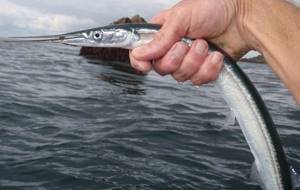
At home, garfish do not grow more than 0.3 m, however, a school of silver arrow-shaped fish requires a large volume of water. It can show its predatory character and eat its neighbors in its living space.
When keeping freshwater garfish in an aquarium, it is necessary to monitor the water temperature and acidity. The thermometer should show 22-28 °C, the acidity tester should show 6.9...7.4 pH. The food of aquarium garfish corresponds to their character - these are pieces of fish, live food: bloodworms, shrimp, tadpoles.
The arrowfish also shows a passion for jumping when kept at home. When servicing an aquarium, it gets scared and can jump out of the water and injure a person with its sharp beak. Sharp, high-speed throws sometimes cause damage to the fish itself: it breaks its elongated jaws, similar to thin tweezers.
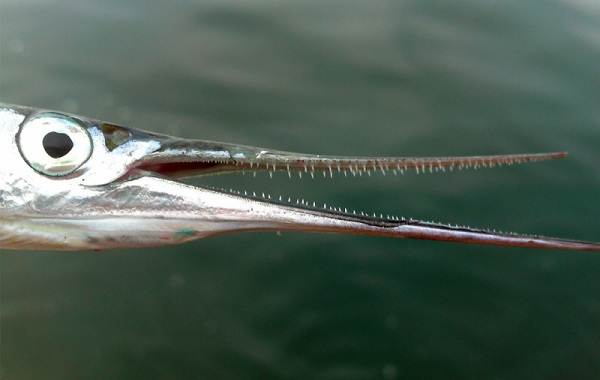
Social structure and reproduction
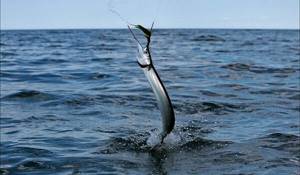
Photo: Garfish in the sea
Garfish become mature at the age of 2 years. Then the fish first goes to spawn. The total life expectancy is on average 6-7 years. Although there have been cases recorded when garfish in the wild lived up to 13-15 years.
The fish go to the seashore to spawn. Spawning time depends directly on the habitat of the fish. In the Mediterranean Sea, the start of spawning is March, but in the North Sea it is May. That is, in general, garfish go to spawn when the water warms up enough. But it should be borne in mind that in the future, any weather conditions (changes in temperature, water salinity level) will have virtually no effect on spawning, which can last for many months. According to statistics, its peak occurs in mid-summer. Even if some conditions are unfavorable, this will not change the situation in any way and the garfish will in any case lay eggs as usual.
In order to lay eggs, an adult female garfish comes closer to algae or rocky areas. The female can lay eggs to a depth of 1-15 m. On average, from 30 to 50 thousand eggs are laid at a time. Garfish eggs are very large - they can reach 3.5 mm in diameter and also have a spherical shape. To securely attach to the surface of algae or underwater rocky structures, adhesive threads are evenly distributed on the secondary shell of the egg.
The fry is formed very quickly - it usually takes about 2 weeks. Young garfish are born mainly at night. The newborn fry is 1-1.5 cm in length and is almost completely physically formed. The gills are fully functional, and the well-developed eyes allow them to navigate freely even in low light. The caudal and dorsal fins are the worst developed at this age. At the same time, the garfish still moves well and quickly.
The color of the fry is brown. Its nutrition is provided by the yolk sac - this allows the fry not to feel the need for food for 3 days. Next, the fry begins to feed on mollusk larvae on its own.
Reproduction and lifespan
To spawn, garfish choose secluded corners among reefs and underwater vegetation, staying close to the coast. 5-year-old males and 6-year-old females begin to reproduce. This is the age of puberty. Older fish, of course, also participate in mating games.
Females lay eggs several times with an interval of 2 weeks. Having started in April, spawning ends only in August.
Algae is needed not only to camouflage eggs. The capsules are attached to plants using adhesive threads. Garfish eggs are placed close to the surface.
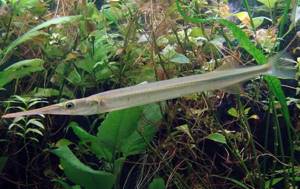
Arrowfish are born one and a half centimeters long and have short jaws. The nose lengthens as the animal grows.
In an aquarium, garfish live up to 4 years. Accordingly, this is the age of freshwater arrows. In their natural environment, they live up to 7 years, starting to spawn earlier than marine species. They live up to 13 years.
Natural enemies of garfish
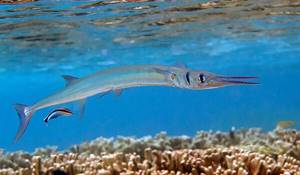
Photo: What a garfish looks like
In nature, garfish have a lot of enemies. We are talking primarily about large predatory fish (tuna, bluefish). Dolphins and seabirds also pose a danger to garfish. At the same time, humans have recently become the most dangerous for garfish. Now the demand for garfish as a commercial fish is increasing, which is why the catch has increased significantly. Against this background, the population may decline significantly.
By the way, the garfish itself can also pose a danger even to people. At night, they are dangerous for divers because they easily catch the light of a flashlight and rush towards it. Strong jaws are quite capable of causing injury. But this applies exclusively to large varieties. Small individuals almost never risk attacking people. Being predators, they hunt exclusively small fish. And then, garfish often prefer to hunt in flocks rather than alone.
Natural enemies during the ripening period pose a much greater danger to garfish. It is the fry and roe of garfish that are most susceptible to attacks. Although adults carefully protect their offspring, many eggs and fry die before reaching puberty. They may also be negatively affected by natural factors during the migration process.
Interesting fact: Large species of garfish can cause harm to fishermen by rapidly jumping out of the water at high speed. Most often, this happens if a garfish is chasing prey or is trying to escape the chase.
Sargan scarf
This dish is especially loved by Crimean fishermen. Shkara consists of two layers of stewed onions, between which there is sea fish. Garfish is an ideal candidate for this dish. Let's try to prepare a “restaurant version”. For this, the garfish is filleted, the strips are rolled up, pinned with a toothpick, and fried in olive oil for literally 20 seconds to set. The wooden sticks are then taken away and a lemon stuffed olive is placed in the middle of each roll. In the usual “fisherman’s” version of the dish, you can skip this stage and simply clean and gut the fish, cutting it into pieces. Next, cut the onion into rings. There must be a lot of it. Moisten the bottom of the pan with vegetable oil and line it with onion rings. Place the fish on them (in the restaurant version, carefully place the rolls with the olive facing up). Salt and sprinkle with pepper and herbs (rosemary and marjoram). Top with three shavings of very cold butter - not too much. And cover the dish with onion rings. To help the stewing process, add a little water to the pan. Shkara should be stewed under the lid for 20 minutes.
Description
Garfish has a memorable appearance and description. This fish is difficult to confuse with any other representative of the ichthyofauna, although there are some similarities with barracuda, eel or needle fish, but it has nothing in common with them in behavior and habitats.
The body of the garfish is elongated, arrow-shaped, narrow and thin. It is covered with dense small cycloid pearlescent light scales. The lateral line runs almost along the belly. There are no spiny fins, the anal and dorsal fins are located almost at the very tail.
The jaws are elongated, resembling a beak. They contain many small but very sharp teeth that can securely hold prey. The eyes are medium in size and located closer to the forehead. The back is dark, the sides and belly are silver.
Note! The Pacific garfish differs from the Black Sea garfish by the presence of a long bluish-blue stripe running through the entire body.
The average size of an adult is 65–75 cm with a body weight of 500 to 800 grams. Sometimes you come across specimens under 90 cm and weighing about 1.2–1.3 kg. In rare cases, it is possible to catch trophies measuring a meter or more in length, but taking such prey is considered an incredible success.
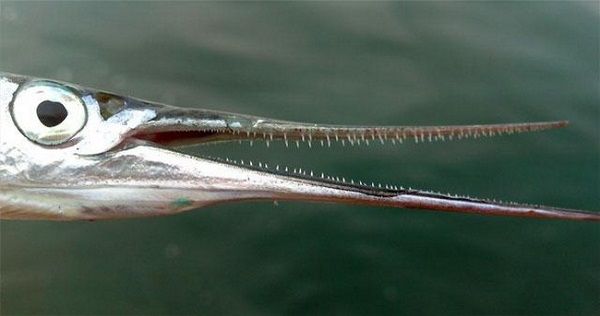
Garfish have small sharp teeth
Garfish are capable of moving very quickly, especially during hunting. At the same time, you can observe how the fish jumps out of the water in pursuit of the fry, trying to escape the chase. There have even been cases where fishermen in a boat were injured from a collision with a jumped-out predator.
The garfish reaches sexual maturity in the fifth to seventh year of life. Unlike most fish, this underwater resident goes to spawn from August to mid-autumn. An adult female is capable of laying up to thirty thousand eggs, much depends on weather conditions, her age and specific habitat.
Spawning of garfish takes place in the coastal zone at shallow depths. The fish chooses areas with the presence of filamentous algae. It is this kind of vegetation that serves as a “shelter” for eggs, which are attached to them and held until maturity.
A garfish egg weighs 3–5 grams. It has several thread-like branches. Under favorable conditions, they mature within two weeks. In bad weather, this process can take up to a month. After which a juvenile arrowfish appears at the count.
Reference! The largest garfish lives in the tropical parts of all oceans. Called crocodile or giant. Can reach sizes up to 6 kg.
The young garfish does not look like an adult fish. It has less elongated jaws, which change with age. As a rule, juveniles acquire all the characteristic features of the species after reaching a year and a half. From this moment on, it leaves the coastal shallows, going to deep areas.
Sargan in marinade
An easy recipe for garfish in marinade, which will be remembered for its outstanding taste. You will need:
- Fresh garfish;
- Onion;
- Salt;
- Sugar;
- Vegetable oil;
- Vinegar.
Preparation time 2 days.
- Gut the fish, rinse thoroughly, peel and cut into strips. Peel the onion and cut into rings of medium thickness.
- The fish is placed in the jar, then the onion, then the fish again, in this manner until the jar is full. Each layer of fish laid out should be lightly salted. If using a 0.5 liter jar, add 1 teaspoon of vinegar. Next, add vegetable oil so that it covers half the contents of the jar.
- Close the container; for the first one and a half to two hours, the jar must be turned over regularly so that all the contents are thoroughly soaked. When one and a half to two hours have passed, the jar needs to be put in the refrigerator and smoked for two days. During this time, regularly remove and turn over so that the contents are soaked.
- After time has passed, take it out and put it on a plate.
Calorie content 1500 kcal, 80 g protein, 80 g fat, 7 g carbohydrates.
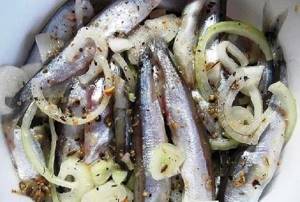
How to smoke
It is easy to smoke a garfish, you will need:
- Salt;
- Dry wine;
- Garfish 1 kg;
- Pepper;
- Wine vinegar;
- Herbs, rosemary and basil.
Cooking time 2 hours.
Step by step recipe:
- When choosing fish for this recipe, you should give preference only to fresh specimens. Thoroughly clean and rinse the carcasses, remove the head. There is no need to peel fish from scales; it will help smoke the meat and remain juicy.
- Pour water into the pan, add pepper, spices, salt. Cook the contents for about 5 minutes, then leave to cool when ready. When the brine has cooled, add wine and vinegar.
- Place the fish in a pan with brine and leave to marinate overnight in a cool place, preferably in the refrigerator. This will eliminate the unpleasant odor characteristic of this fish.
- Next, rinse the fish with cold water, dry thoroughly, and send to the smokehouse. Pre-lubricate the grate with oil, this will prevent the fish from sticking to it during the smoking process.
- The carcasses are laid out in such a way as not to touch each other and smoked at a temperature no higher than 90 degrees.
- Once ready, cool to room temperature and ready to eat. It is recommended to consume within 1-2 days after smoking.
Calorie content 800 kcal, 50 g protein, 30 g fat, 4 g carbohydrates.
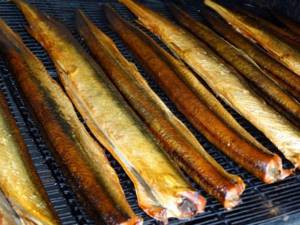
Lifestyle and nutrition
Our hero lives in packs. Swims in the upper layers of water. He is not particularly picky about his diet: he does not disdain small fish, crustaceans, insects, and even the fry of his relatives. All subspecies are characterized by seasonal migrations. Black Sea garfish migrates from the waters in spring
The Black Sea to the Azov Sea for anchovy - a favorite food. By autumn it returns to the Black Sea. And the Pacific swims from Korea in the summer to spawn in Primorye. Males reach sexual maturity at 5 years of age, females a little later, at 6 years.
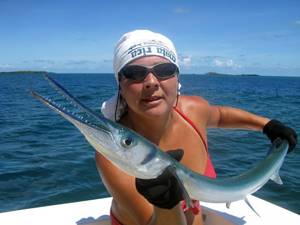
Baked garfish:
- Garfish fillet;
- Flour;
- Salt, pepper, spices;
- Vegetable oil.
Cooking time for the garfish dish is 30 minutes.
Step by step recipe:
- Wash the fish, remove everything unnecessary, cut into several portions so that it is convenient to fry in a frying pan. The cut fish should be soaked in spices, salt and pepper. Spices are chosen to your taste. When the spices are added, the fish must be thoroughly rolled in flour, this will give it a rosy appearance, preserving the juicy meat.
- Pour vegetable oil into a frying pan, heat it up, and add the garfish. Cook until golden brown on both sides. Before serving, place the fish on paper towels to absorb excess fat. Rice or mashed potatoes are served as a side dish. This recipe can also be prepared in the oven, allowing for additional time.
Calorie content of baked garfish is 900 kcal, 60 g protein, 40 g fat, 7 g carbohydrates.
